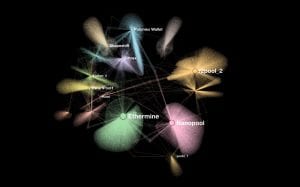Determining the major player in the blockchain using hubs and authorities
https://media.consensys.net/the-hubs-authorities-in-transaction-network-powered-by-sansa-and-graph-analysis-9bf271c2e5f9
Blockchain has been a very hot topic recently and this article digs into the Ethereum blockchain to identify the major players across the transaction network. The data set was huge so scientists first limited dataset to 10000 blocks which is from block 4100000 to block 4109999. By limiting the dataset to 10,000 blocks, scientists effectively truncated the whole transaction history. However, there were definitely isolated nodes standing alone next to the main connected node cluster. These nodes would be of no interest for them as they could not be the major plays without connectivity. Therefore, they filtered them out and proceeded to find the largest cluster inside the remaining transaction graph. In this case, scientists favored Connected Components over the Strongly Connected Components. As we learned in the class, Strongly Connected Components requires all the node pairs in the graph to be reachable in either direction. For finding major players, scientists care about the interactions between nodes, so direction does not really matter. Scientists then filtered out the self-loop edges from the Connected Components.
With this left refined graph, hubs and authorities comes into the scene to help scientists decide the major players. They looked further into the associated transaction behavior. Three typical patterns can be distinguished, which jointly identify them as exchange deposit wallets:
- Frequently paying out to certain exchanges’ main wallets with a fixed, large value.
- Frequently receiving funds from the same exchange main wallets, and paying out to various token contracts.
- Frequently receiving funds from a group of “miner” accounts, with “proxy” accounts in between, which clean out their received ETH within a short time window.
As we learned in the class, nodes that are frequently paying out to certain exchanges’ main wallets with a fixed, large value are actually hubs that have links to authorities and nodes that frequently receiving funds from a group of “miner” accounts are actually authorities that have a group of links pointing to it. However, sometimes, authorities are also hubs that have links to other nudes while hubs are also authorities that have links pointing to it which in this case, are nodes that frequently receiving funds from the same exchange main wallets, and paying out to various token contracts. With this hubs and authorities concept being used, scientists eventually found the relationships in this transaction network which is the graph at the top and the major players are represented by their names in the graph.

